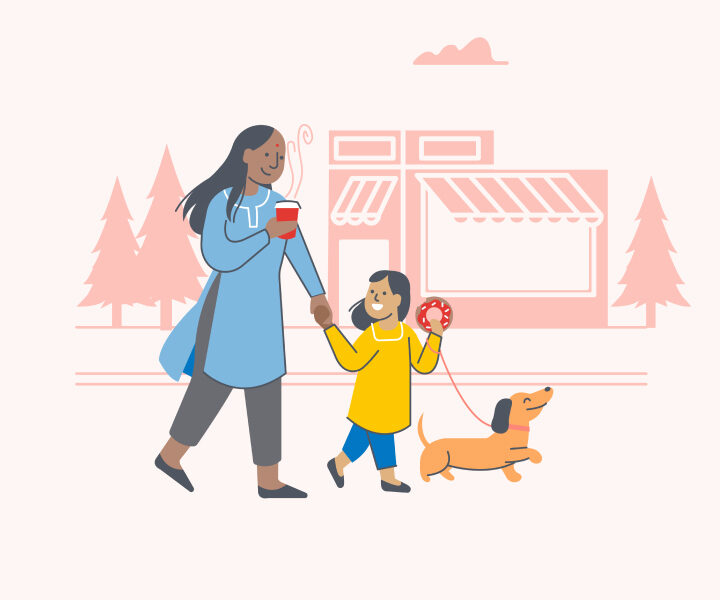Child Tax Benefits: The Canada Child Benefit (CCB) Guide for Beginners
TurboTax Canada
January 22, 2025 | 5 Min Read
Updated for tax year 2025

Key Takeaways
- The Canada child benefit (CCB) provides a tax-free monthly payment to families to help them with the cost of raising children under the age of 18.
- You must meet specific criteria to qualify for the CCB, such as living with the eligible child/children and being a resident of Canada.
- You could receive a benefit of up to $7,997 per child annually.
What is the Canada child benefit (CCB)?
Who is eligible for child benefits in Canada?
A parent can apply for benefits any time after a child’s birth or upon meeting the qualifications for the application. The specific criteria to be eligible for child benefits in Canada are:
- You live with a child who is under the age of 18
- You hold primary responsibility for that child
- You are a Canadian resident for tax purposes
For couples, you, your spouse, or your common-law partner must be one of the following:
- A Canadian citizen
- A permanent resident of Canada or a temporary resident of Canada for at least 18 months
- A protected person
- Registered under the Indian Act
Along with the above eligibility, the government takes a look at the net family income (the net income of both parents) on an annual basis. And if the combined income does not exceed the threshold, then they would be eligible for the credit. So, both parents have to file income tax returns (T1)—even if they earned no income during the year—to be considered.
Note: Families who foster children cannot receive CCB payments for any months that children’s special allowances (CSA) are paid.
How does the Canada child benefit work?
The CCB works on a sliding scale. There is no set amount per child, per month, or per year; instead, payment amounts vary and are reassessed in July each year.
Payments are based on the following factors:
- How many children you have
- The age(s) of your child(ren)
- Your marital status
- Your family income as reported on your tax return from the previous year
Family income is the net income reported by you and your spouse and does not include anything you may receive from the universal child care benefit (UCCB) or registered disability savings plans (RDSP).
Since the CCB payment is adjusted based on your family income—it decreases as your income increases—the benefit can be most helpful to low- and moderate-income families. But parents who believe they won’t qualify to receive the benefits based on their income should apply anyway because the family income level cutoff has changed significantly with the introduction of the CCB. You can find a handy CRA calculator here to help you with the math.
What is the maximum CCB per child?
Families who reported a combined income of $37,487 at the end of 2025 can qualify for the maximum 2025-2026 payment benefit.
For July 2025 through June 2026, the maximum payment amounts are:
- $7,997 per year ($666.41 per month) for each child under 6 years old
- $6,748 per year ($562.33 per month) for each child 6–17 years old
Depending on how far over the threshold you are, you may qualify for a lesser payment each month.
How is the CCB calculated?
Why does marital status matter?
If you marry, you need to prepare for the possibility that you and your partner’s combined AFNI may reduce your payments or disqualify you from receiving the benefits at all.
The same holds true for when you add another child to your household, or if there’s an employment change—because the higher the family income, the lower the benefits.
If you become separated, widowed, or divorced, you should contact the CRA right away and have them update your personal tax account because there could be implications. For example, if you are the sole parent responsible for a child who is qualified for the disability tax credit and you apply for the child disability benefit, then you need the CRA to understand that it is now only your income they need to take into consideration.
Also, important to know: shared custody can affect your eligibility. For instance, if the CRA considers you to have shared custody of your child, you will get 50% of what you would have gotten if you had full custody. The amount is calculated based on each parent’s AFNI. Those in temporary living arrangements may also qualify for benefits, depending on the length of time a parent is the primary caregiver. So it’s important to report any changes to shared custody agreements as soon as possible.
The best way to confirm your eligibility for benefits is to file your taxes annually. So, the sooner you contact the CRA on your marital status, the quicker your benefits can be recalculated.
When do I receive my Canada child benefit payments?
Unlike other annual tax credits and benefits, you’ll receive the CCB each month. Generally, payments arrive between the 18th and 20th, though the schedule is adjusted each year.
For quick reference, the CRA publishes the payment schedule on its website.
How do I apply for the CCB?
Get the tax support you deserve.
Related articles

© 1997-2024 Intuit, Inc. All rights reserved. Intuit, QuickBooks, QB, TurboTax, Profile, and Mint are registered trademarks of Intuit Inc. Terms and conditions, features, support, pricing, and service options subject to change without notice.
Copyright © Intuit Canada ULC, 2024. All rights reserved.
The views expressed on this site are intended to provide generalized financial information designed to educate a broad segment of the public; it does not give personalized tax, investment, legal, or other business and professional advice. Before taking any action, you should always seek the assistance of a professional who knows your particular situation for advice on taxes, your investments, the law, or any other business and professional matters that affect you and/or your business.









